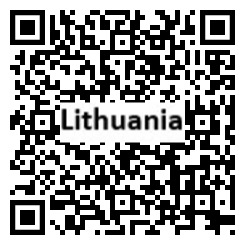Country Summary




Introduction
Background
Lithuanian lands were united in 1236. Over the next century, through alliances and conquest, Lithuania extended its territory to include most of present-day Belarus and Ukraine. By the end of the 14th century Lithuania was the largest state in Europe. Lithuania was annexed by the USSR in 1940. On 11 March 1990, Lithuania became the first of the Soviet republics to declare its independence.
Geography
Area
total: 65,300 sq km
land: 62,680 sq km
water: 2,620 sq km
Climate
transitional, between maritime and continental; wet, moderate winters and summers
Natural resources
peat, arable land, amber
People and Society
Population
2,683,546 (2022 est.)
Ethnic groups
Lithuanian 84.6%, Polish 6.5%, Russian 5%, Belarusian 1%, other 1.1%, unspecified 1.8% (2021 est.)
Languages
Lithuanian (official) 85.3%, Russian 6.8%, Polish 5.1%, other 1.1%, two mother tongues 1.7% (2021 est.)
Religions
Roman Catholic 74.2%, Russian Orthodox 3.7%, Old Believer 0.6%, Evangelical Lutheran 0.6%, Evangelical Reformist 0.2%, other (including Sunni Muslim, Jewish, Greek Catholic, and Karaite) 0.9%, none 6.1%, unspecified 13.7% (2021 est.)
Population growth rate
-1.04% (2022 est.)
Government
Government type
semi-presidential republic
Capital
name: Vilnius
Executive branch
chief of state: President Gitanas NAUSEDA (since 12 July 2019)
head of government: Prime Minister Ingrida SIMONYTE (since 24 November 2020)
Legislative branch
description: unicameral Parliament or Seimas (141 seats; 71 members directly elected in single-seat constituencies by absolute majority vote and 70 directly elected in a single nationwide constituency by proportional representation vote; members serve 4-year terms)
Economy
Economic overview
high-income, EU-member, largest Baltic economy; privatized most state-owned enterprises; unmoved youth emigration; systemic corruption; issued Europe’s first bank-backed digital coin (LBCOIN); highly educated workforce; lowest EU household debt
Real GDP (purchasing power parity)
$102.66 billion (2020 est.)
Real GDP per capita
$36,700 (2020 est.)
Agricultural products
wheat, milk, sugar beet, rapeseed, barley, triticale, potatoes, oats, peas, beans
Industries
metal-cutting machine tools, electric motors, televisions, refrigerators and freezers, petroleum refining, shipbuilding (small ships), furniture, textiles, food processing, fertilizer, agricultural machinery, optical equipment, lasers, electronic components, computers, amber jewelry, information technology, video game development, app/software development, biotechnology
Exports
$41.48 billion (2020 est.)
Exports - partners
Russia 13%, Latvia 9%, Poland 8%, Germany 7%, Estonia 5% (2019)
Exports - commodities
refined petroleum, furniture, cigarettes, wheat, polyethylene (2019)
Imports
$36.06 billion (2020 est.)
Imports - partners
Poland 12%, Russia 12%, Germany 12%, Latvia 7%, Netherlands 5% (2019)
Imports - commodities
crude petroleum, cars, packaged medicines, refined petroleum, electricity (2019)
Exchange rates
litai (LTL) per US dollar -
Page last updated: Tuesday, November 15, 2022
